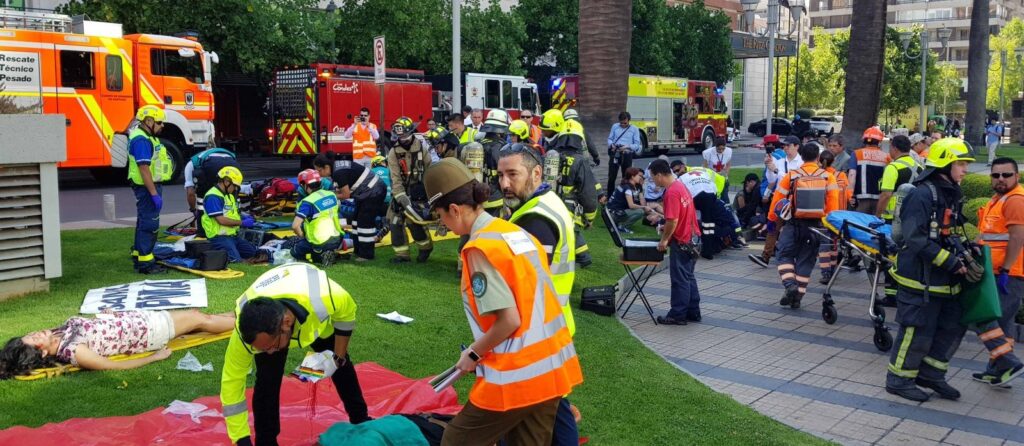In a mass casualty event, such as a terror attack, earthquake or major car accident, the immediately available medical resources and personnel who rush to the scene simply cannot cope with the number of victims or the severity of their injuries.
And trying to make order among the sheer number of shocked and injured people can be overwhelming, even for the most experienced first responder.
A new algorithm devised by Omer Perry, a lecturer at Afeka College of Engineering in Tel Aviv is designed to help emergency personnel handle the tough task of getting victims to hospital in the immediate aftermath of such an event.
The algorithm comes into play in what Perry describes as phase three of a mass casualty event. Phase one is the evaluation of the scene in terms of numbers of casualties, phase two is the start of treatment at the scene and phase three is the evacuation of the wounded.
“In this [third] phase, there is a peak of cognitive overload,” Perry tells NoCamels, referring to the massive amounts of information with which the person in charge of managing the situation, known as an incident commander, has to contend.
“And in this peak of cognitive overload, we need to think about how to make it easier for the incident commander to manage this type of matching process,” Perry says.

And this is where artificial intelligence “comes to life,” with an algorithm that is able to work out which casualties are in need of the most urgent care, taking some of the pressure off the person in charge at the scene.
“The algorithm prioritizes the casualties,” he says. “It will lower the cognitive overload of the incident commander, so it will be easier for everyone.”
The algorithm analyzes data about the number of casualties and severity of the wounds they sustained, and calculates which victims should be placed in which ambulances and to which medical center they should be sent, explains Perry.
This is because ambulances and medical centers differ in the range of special capabilities and treatments they offer, and because some victims of trauma require more urgent care en route to hospital and must be dispatched to the closest location due to the severity of their wounds.
“Let’s say, for example, that we have an urgent casualty who needs to go in an ALS,” Perry says, referring to an Advanced Life Support ambulance.
“The ALS can carry one urgent casualty and two non-urgent casualties. And there is a dilemma: do we upload an urgent casualty and wait a couple of minutes to bring another two non-urgent casualties, or send the ambulance only with the urgent casualty?”
Sign up for our free weekly newsletter
SubscribeThe algorithm is built to cope with these types of decisions, says Perry. When the incident commander is on site with information about the number of casualties and the number of ambulances, the algorithm starts working and provides the answers to such dilemmas.

While the incident commander can input the data into the algorithm, Perry explains it is preferable for this side to be handled by a dispatch, someone removed from the often chaotic scene who will then feed the people on site the information they need about which casualty goes where and when.
He developed the algorithm during his PhD studies at Ben-Gurion University of the Negev, under the supervision of Prof. Avishay Goldberg, chair of the Department of Health Systems Management, and Prof. Yuval Bitan of the Department of Health Policy and Management.
As part of his studies, Perry built a simulator to train paramedics in managing mass casualty events, and from there came the idea for the algorithm to help manage the dispatch of casualties to hospital.
To build the algorithm, Perry collaborated with Dr. Eli Jaffe, the director of training, volunteer activities and international relations at Israel’s national emergency service Magen David Adom, and also enlisted the help of three of his own students in artificial intelligence at Afeka – Shiri Goren, Yuval Deknuydt and Raanan Yossef.
And many of his students, he tells NoCamels, have been working on this new way to help others while struggling with their own personal crises – missing school due to military service as Israel battles Hamas in Gaza and later coping with the impact of fighting a war.
He also pays tribute to Afeka President Prof. Ami Moyal, whom he says has vowed that not one student will be allowed to drop out this academic year due to the war.
Perry says the students were an integral part of developing the algorithm, which took a year to create, after he spent around two years mulling over how to resolve this issue. The students also developed a simulator used to test the algorithm and now with Perry are working on two new algorithms.
The next task, according to Perry, is to incorporate the algorithm into the simulator used to train paramedics from Magen David Adom.
“You can see human challenges and limitations come to life,” he says of his work.
And when you can evaluate them and measure them, then you can decide what to do in order to cope with these challenges.”
Related posts

Editors’ & Readers’ Choice: 10 Favorite NoCamels Articles

Forward Facing: What Does The Future Hold For Israeli High-Tech?

Impact Innovation: Israeli Startups That Could Shape Our Future




Facebook comments